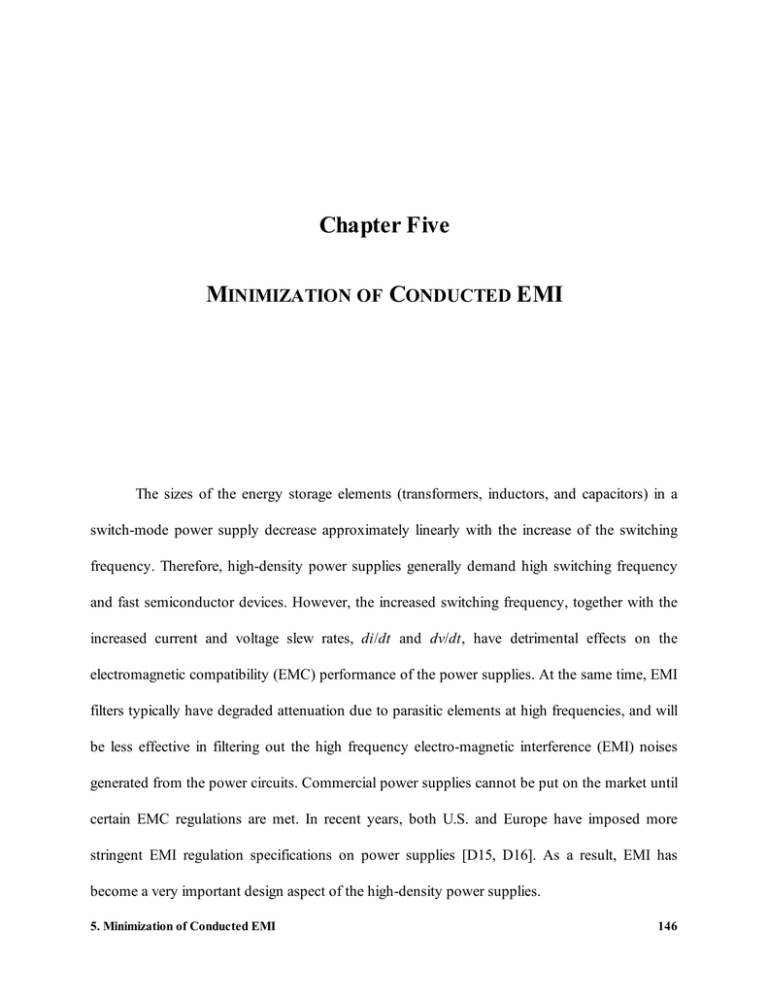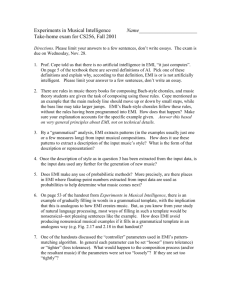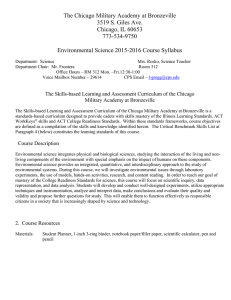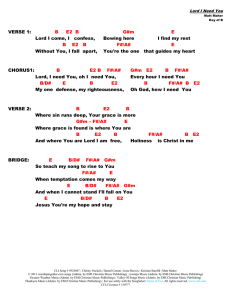Chapter Five M C EMI
advertisement

5.MINIMIZATION OF CONDUCTED EMI Chapter Five MINIMIZATION OF CONDUCTED EMI The sizes of the energy storage elements (transformers, inductors, and capacitors) in a switch-mode power supply decrease approximately linearly with the increase of the switching frequency. Therefore, high-density power supplies generally demand high switching frequency and fast semiconductor devices. However, the increased switching frequency, together with the increased current and voltage slew rates, di/dt and dv/dt, have detrimental effects on the electromagnetic compatibility (EMC) performance of the power supplies. At the same time, EMI filters typically have degraded attenuation due to parasitic elements at high frequencies, and will be less effective in filtering out the high frequency electro-magnetic interference (EMI) noises generated from the power circuits. Commercial power supplies cannot be put on the market until certain EMC regulations are met. In recent years, both U.S. and Europe have imposed more stringent EMI regulation specifications on power supplies [D15, D16]. As a result, EMI has become a very important design aspect of the high-density power supplies. 5. Minimization of Conducted EMI 146 In the past, EMC design remained a myth to the power electronics field. EMI practices usually take last-minute, trial-and-error experimental methods without careful planning and design. Furthermore, this last-minute patch-on solution sometimes cannot even meet the regulation requirement and calls for redesign of the entire converter, which inevitably delays the time to the market. Recently a number of attempts have been reported to address the theoretical analysis of EMI noises for power supplies, and to perform an early-phase EMI design. However, they are limited to specific, simplified converter switching cells and are difficult to apply to general complete power converters. This chapter develops a systematic approach to the conducted EMC design aspect of high-density power supplies. Converter components are accurately modeled, with the parasitic elements extracted to reveal their impacts on the EMI noises. Circuit simulations are used to analyze and minimize the EMI noises. As an example, the same 36-W flyback adapter analyzed in Chapter 4 is used to demonstrate the design procedures of this approach. 5.1. Parasitic Parameter Extraction - Example: Flyback Adapter Conducted EMI noises are generated from power supplies due to the switching actions of the semiconductor devices. Although the EMI regulation specifications target the total EMI emission, the noises can be divided into differential-mode and common-mode noises in order to more effectively minimize each noise for an overall emission suppression. Generally, the differential-mode noise is predominantly caused by the magnetic coupling L·di/dt, where L is the 5. Minimization of Conducted EMI 147 parasitic loop inductance which experiences high switching current slew rate di/dt. On the other hand, the common-mode noise is mainly related to the electrical coupling C·dv/dt, where C is the parasitic common-mode capacitance which sees high voltage slew rate dv/dt. Therefore, it is essential to model the parasitic elements in the circuit accurately for the analysis of the EMI noises. 5.1.1. Layout Inductance Calculation Conventionally, the parasitic inductance is extracted using finite-element-analysis (FEA) by solving the Maxwell’s differential field equations. For a complex structure, this method requires extensive computation, and sometimes shows poor convergence. In addition, it requires the predetermination of the current loop for calculation. This presents a difficulty for power converters because current loops vary in different sub-topologies, which are determined by the switching combinations of semiconductor devices. The partial element equivalent circuit (PEEC) method overcomes all the above obstacles [D17-D21]. The principles of this method are explained in detail in Appendix III. The PEEC method uses Maxwell’s integral equations instead of differential equations, and calculates inductance analytically, based on the geometry information only, which only involves matrix manipulations. It also breaks the loop inductance into partial inductance associated with each trace, and relates these partial inductances with mutual inductances, so that the overall loop inductance can be easily computed for any arbitrary combination of traces. Therefore, it can be easily applied to nonlinear switching circuits. 5. Minimization of Conducted EMI 148 A software package, Inductance Calculation (InCa), is developed based on the PEEC method and performs the partial inductance and resistance calculations [E11]. It is used to extract the parasitic parameters associated with the power-stage PCB layout of the flyback adapter, shown in Fig. 5.1. The calculated parasitic inductance, Lp, and the trace resistance, Rp, using PEEC method are expressed in the following matrix forms: . − 0.4 − 0.4 − 2.6 − 0.3 10 . 22.4 45.9 − 4.6 − 3.4 − 13 10.2 16.3 10 . 2.3 0.9 0.6 07 . 0.3 − 0.3 6.2 10.9 0 0 0 1.4 0 − 0.6 20.0 2.4 3.6 0 0.9 0 6.2 5.8 07 . 0 0.2 0 nH , R p = 3.9 mΩ , Lp = 8.0 0 0.4 0 5.0 8.9 316 . 0 − 87 . 5.1 0 2.0 37 10.2 . (5-1) where the diagonal terms of the Lp matrix are the self inductances, and the off-diagonal terms are the mutual inductances. An equivalent circuit of the parasitic elements is shown in Fig. 5.2, where all the parasitic inductors are shown in the light color. As can be clearly seen from Fig. 5.2, there is no predetermined loop parasitic inductance, and Lp1-Lp9 form the loop inductance according to the switching topologies. 5. Minimization of Conducted EMI 149 L1 L2 L3 Filter EMI tifier e Rec Bridg L4 tor onnec AC C L5 Cin L6 r forme Trans L7 L9 Figure 5.1. Co L8 PCB layout of flyback converter (the traces are the crucial traces). The labeled inductances corresponds to the parasitic inductances shown in Fig. 5.2. 5. Minimization of Conducted EMI 150 L3 L2 L1 X-Cap EMI Filter L5 L7 L8 + Bridge Rectifier Ccom2 , 6p Co Cin L6 L4 Figure 5.2. L9 Ccom1 , 3p Vo - Equivalent circuit of parasitic elements in layout and packaging (shown in light color). Note: the mutual inductance and the parasitic trace resistance are not shown explicitly, and the dotted portion of the circuit is the EMI filter. 5. Minimization of Conducted EMI 151 5.1.2. Packaging Capacitance Calculation The common-mode capacitance, Ccom, consists of the capacitances between the chassis ground and the electrical nodes which experience voltage changes (dv/dt ≠ 0). In order to reduce the junction temperatures, the semiconductor devices are usually mounted on heatsinks, which are connected to chassis ground for safety. Therefore, Ccom is mainly determined by semiconductor devices because of the relatively large parasitic common-mode capacitances between the heatsinks and the cases of the semiconductors, which are electrically connected either to the fast-switching MOSFET drains or to diode anodes. To calculate the common-mode capacitance between the device case and the heatsink (which usually are separated only by a thin layer of isolation material), the analytical Wheeler/Schneider formula can be used (a modified parallel-plate formula), i.e., C= ε eff πε o ε eff 1 8h ln 1 + 2 w eff 8 h 8h + w w eff eff − ε − 1 ε − 1 10h = + 1 + 2 2 w 1 2 ; w eff = w + 2 2 + π t ln π ⋅l ; 4e t ( )2 +[ h 1 w π ( + 11 .) t } ] (5-2) 2 where w, l, t are the width, length, and thickness of the case, respectively, h is the spacing between the case and the heatsink, and ε is the dielectric constant [D22]. The parasitic commonmode capacitance associated with the primary switch and the secondary rectifier for the example adapter is calculated for the flyback converter packaging using Eq. (5-2), and shown in Fig. 5.2. 5. Minimization of Conducted EMI 152 5.2. Circuit Modeling and EMI Analysis - Example: Flyback Adapter In addition to the layout and packaging parasitics, to predict the EMI performance accurately, the high-frequency characteristics of the components in a converter need to be appropriately modeled so that the high frequency circuit behavior and the EMI coupling mechanism can be correctly determined. 5.2.1. Power Transformer Modeling Other than the power switches (their models are usually available from semiconductor manufacturers, and are beyond the scope of this work), which generate the high-frequency di/dt and dv/dt slew rates, the power transformer is the most critical and complex component in terms of the EMI performance of the isolated power converters. For an accurate analysis, FEA is usually used to determine the electromagnetic characteristics of a transformer, which requires extensive utilization of electromagnetic field analysis and simulation time. In addition, the results are difficult to apply directly to EMI analysis. In contrast, the two-winding transformer method models the high-frequency characteristics of a transformer using equivalent circuit based on transformer impedance measurement [D23]. The transformer open-circuit impedance, Zo, and short-circuit impedance, Zsc, are measured, and consequently can be used to characterize the transformer behavior using a corresponding equivalent circuit. 5. Minimization of Conducted EMI 153 The power transformer used in the flyback adapter is modeled using this method. Figure 5.3 shows the derived equivalent circuit of the power transformer. The magnetizing and leakage inductances, winding capacitances, winding resistances, and core loss resistances are modeled. The measured and simulated open-circuit impedances, Zo, and short-circuit impedances, Zsc, are compared and shown in Figs. 5.4(b) and 5.4(c). It can be seen that the modeled impedance characteristics (on the right) agree very well with the measurements (on the left). It should be noted that in the short-circuit measurement, where only the leakage inductance of the transformer is present, lead inductance introduced by the test setup and the equipment causes artificial high frequency resonances at 20 MHz and 30 MHz. The equivalent circuit in Fig. 5.3 predicts a capacitive 20 dB/dec rolloff after the leakage inductance and the winding capacitance resonance around 10 MHz. Therefore, the impedance model shown in Fig. 5.4(b) is modified to account for the effects of the introduced lead inductance in the measurement. However, this artificial resonance is not present in the actual converter. 5.2.2. Modeling of LISN The conducted EMI measurement procedure requires a 50 Ω/ 50 µH line impedance stabilization network (LISN) to be inserted between the equipment under test (EUT) and the ac utility line to provide a specified measuring impedance for noise voltage measurement, and to isolate the EUT and the measuring equipment from the utility at radio frequencies. A circuit model of the LISN, which is required in the EMI simulation, is shown in Fig. 5.5. The simulated and measured conducted EMI noise voltages are taken across the 50-Ω resistor, and compared with experimental measurements. 5. Minimization of Conducted EMI 154 C3 230p 5.46 : 1 L lk 0.94 µ R1 307m C1 98p Figure 5.3. Rp 193k Lm 1.32m R2 703m Rp 193k Lm 1.32m C2 -65p Reduced equivalent circuit of power transformer: Lm: magnetizing inductance; Llk: leakage inductance; C1-C3: winding capacitances; R1, R2: winding resistances; Rp: core-loss resistance. Note that C2 is negative due to the energy balance. However, all the measurable capacitances, formed by the combinations of C1-C3, are positive. 5. Minimization of Conducted EMI 155 Measurement Model 1E+5 1E+3 100 ∠ Zo Phase [°] Magnitude [Ω] 1E+4 0 1E+2 1E+1 (100) Zo 1E+0 2E-1 1.0E+2 1.0E+3 1.0E+4 1.0E+5 1.0E+6 1.0E+7 4.0E+7 Frequency [Hz] (a) 100 1E+4 ∠ Z sc 50 Phase [°] Magnitude [Ω] 1E+3 1E+2 0 1E+1 Z sc (50) 1E+0 2E-1 1.0E+2 1.0E+3 1.0E+4 1.0E+5 1.0E+6 (100) 1.0E+7 4.0E+7 Frequency [Hz] Figure 5.4. (b) Comparison of power transformer impedance measurement and modeling: (a) open-circuit Zo; (b) short-circuit Zsc. 5. Minimization of Conducted EMI 156 to utility 50 µΗ 1 µF Figure 5.5. 0.1 µF to EDT Rterm 50 Ω Circuit diagram of LISN. 5. Minimization of Conducted EMI 157 5.2.3. EMI Analysis Taking the circuit models shown in Figs. 5.2, 5.3, and 5.5, a complete circuit model can be formed. Using an electrical circuit simulator, e.g., Saber, the conducted EMI performance of the studied power supply can be examined. Figure 5.6 shows the simulated EMI noises for the flyback adapter at high line input voltage (265 Vac). The conducted EMI noises can be divided into common-mode and differential-mode noises, by performing the following calculation: V R term1 + V R term2 V = , com 2 V R term1 − V R term2 V = diff 2 (5-3) where VRterm1 and VRterm2 are the noise voltages across the termination resistors in Fig. 5.5, respectively. As can be seen 5.6, the conducted EMI noise in this particular adapter is commonmode-dominant. Namely, the common-mode noise is about 10 dB higher than the differentialmode noise throughout the regulation frequency band (150 kHz - 30 MHz). Figure 5.6(c) plots the total conducted EMI noise, which is the sum of common-mode and differential-mode noises: Vtotal = Vcom + Vdiff . (5-4) Figure 5.6(c) also shows the FCC Class-B conducted emission limit. It is clear that the emission from the flyback adapter does not meet the regulatory requirement. 5. Minimization of Conducted EMI 158 dBµV 0.15 6.12 12.09 18.06 24.03 30 MHz (a) 0.15 6.12 12.09 18.06 24.03 30 MHz (b) 24.03 30 MHz (c) dBµV dBµV FCC Class B 0.15 Figure 5.6. 6.12 12.09 18.06 Simulated conducted EMI noises at Vin = 265 Vac: (a) differential-mode noise; (b) common-mode noise; (b) total noise. 5. Minimization of Conducted EMI 159 5.3. EMI Noise Suppression - Example: Flyback Adapter The methods of reducing the conducted EMI noises in a switching converter can involve either suppressing generated EMI noise sources by careful layout planning and packaging designs, or attenuating the generated noises by using EMI filters. The first approach focuses on reducing the inherent noise within the converter. The attenuation approach is widely used because it does not require modification of power converter design, and EMI filters can be external add-on modules. Using the filter attenuation alone to meet the EMI regulation, filter size may become a hurdle to achieving high power density. Therefore, for high-density power supplies, EMI filter should be designed based on an optimized layout and packaging of the converter, to minimize the size and the weight of the EMI filter. 5.3.1. Layout Improvement As can be seen from the equivalent circuit of the flyback adapter (Fig. 5.2), the fastswitching currents exist in the primary loop (L4 - L5 - L6) and the secondary loop (L7 - L8 - L9). Figure 5.1 shows that the secondary loop area is already minimized, while the primary loop (traces shown in the dark color) has relatively large loop area. Therefore, an improved circuit layout can be designed by reducing the primary loop area, as shown in Fig. 5.7, so that its loop inductance is reduced, and the L·di/dt effect consequently decreases. Furthermore, a groundreferenced metal layer for radiated EMI shielding is added, which acts as a ground plane and effectively reducing the parasitic inductance to Lp' , as 5. Minimization of Conducted EMI 160 Figure 5.7. Improved PCB layout of flyback converter (the traces are the improved traces and the layer is the EMI shielding acting as a ground plane ). 5. Minimization of Conducted EMI 161 . − 1.5 − 0.4 0 0 327 130 0.1 0.3 0.1 . 8.6 0 0 130 . 0.6 4.9 Lp ' = 0 0 0 0 0 0 11 0 0 0 . 0 0 0 0 nH , 6.5 0 0 0 19.5 0 − 36 . 4.0 0 7.4 0 0 0 0 0 0 22.4 10.2 6.2 6.2 R p ' = 3.9 mΩ . 5.0 8.9 2.0 . 37 (5-5) Compared with the matrices shown in Eq. (5-1), not only the self-inductances (the diagonal terms) are reduced, but so are the mutual-inductances (off-diagonal terms). Therefore, the mutual coupling between traces is much reduced. Since differential-mode noise is directly related to L·di/dt, it should consequently be reduced with this improved layout and packaging implementation. Figures 5.8(a) - 5.8(c) show the simulated EMI noises with the improved layout and packaging. As can be seen from the comparison with the noises in Fig. 5.6, the differential noise is reduced by approximately 10 dB, especially for the high frequency region, while the commonmode and total noises remain approximately the same. Although the adapter is common-mode dominant, the differential-mode noise reduction alleviates the requirement for differential-mode attenuation and can reduce the EMI filter size to increase the adapter power-density. In some situations, minimized differential-mode noise can lead to EMI filter designs that utilize the leakage inductance of common-mode filters for differential-mode attenuation. Therefore, the improved layout and packaging design has a better EMI performance. However, the total EMI noise shown in Fig. 5.8(c) still exceeds the Class-B regulation limit, and further measures need to be taken to satisfy the regulatory specification. 5. Minimization of Conducted EMI 162 dBµV 0.15 6.12 12.09 0.15 6.12 12.09 18.06 24.03 30 MHz (a) dBµV 18.06 24.03 30 MHz (b) 24.03 30 MHz (c) dBµV FCC Class B 0.15 Figure 5.8. 6.12 12.09 18.06 Simulated conducted EMI noises for improved layout and packaging at Vin = 265 Vac: (a) differential-mode noise; (b) common-mode noise; (b) total noise. 5. Minimization of Conducted EMI 163 5.3.2. Input Filter Design With the minimized conducted EMI emission from the converter by proper layout and packaging, an EMI filter can be designed to further attenuate the generated EMI noises seen from the utility lines. EMI filters can be categorized into common-mode filters and differential-mode filters, addressing different filter requirements [D24]. As can be seen from Fig. 5.5, 40-dB attenuation for the common-mode noise and 20-dB attenuation for the differential-mode noise are required to bring the noise levels under the emission limit. With 3.3-nF safety-required Y-caps, a 32-mH common-mode inductor will provide the required 40-dB attenuation (design procedures detailed in [D24]). With the minimized differential-mode noise, the leakage inductance (50 µH) of the wounded common-mode choke would have sufficient differential-mode attenuation. Figure 5.9 shows the equivalent circuit of the common-mode inductor (L1), together with the measured and simulated characteristics. As can be seen from Fig. 5.9, the significant parasitic winding capacitance (8 pF) in L1 due to a large number of turns reduces the attenuation effectiveness at high frequency (> 300 kHz), i.e., the inductor becomes capacitive above 300 kHz. To remedy the problem, an additional small common-mode inductor (L2), which has very few turns and negligible winding capacitance and leakage inductance, can be connected in series with the first large inductor to provide the required high frequency attenuation. The equivalent circuit and the characteristics of L2 are shown in Fig. 5.10, where the inductive behavior is kept throughout the conducted EMC regulatory frequency range (150 kHz - 30 MHz). Figure 5.11 shows the overall common-mode and differential-mode attenuation of the designed EMI filter. As can be seen from Fig. 5.11, with the high-frequency attenuation compensation from L2, the required attenuation is achieved. 5. Minimization of Conducted EMI 164 Rcore 50k Cwind 8p Lcom K=1 32m L lk 50µ Rwind 0.25 Cwind 8p Rcore 50k (a) Measurement Model 100 5E+4 ∠ Z 1_com 50 0 5E+2 Z 1_com 5E+1 5E+0 1.0E+2 Phase [°] Magnitude [Ω] 5E+3 1.0E+3 1.0E+4 (50) 1.0E+5 1.0E+6 (100) 1.0E+7 4.0E+7 Frequency [Hz] (b) 1E+5 100 ∠ Z 1_dif 1E+3 50 Phase [°] Magnitude [Ω] 1E+4 0 1E+2 Z 1_dif 1E+1 (50) 1E+0 2E-1 1.0E+2 1.0E+3 1.0E+4 1.0E+5 1.0E+6 (100) 1.0E+7 4.0E+7 Frequency [Hz] Figure 5.9. (c) Comparison of common-mode choke (L1) impedance measurement and modeling: (a) equivalent circuit; (b) common-mode Zcom; (c) differential-mode Zdif. 5. Minimization of Conducted EMI 165 R core 3.3k C wind 0.8p Lcom K=1 477µ L lk 2µ Rwind 8m C wind 0.8p R core 3.3k (a) Measurement Model 100 ∠ Z 2_com 50 1E+2 0 1E+1 Z 2_com 1E+0 2E-1 1.0E+2 Phase [°] Magnitude [Ω] 1E+3 1.0E+3 1.0E+4 (50) 1.0E+5 1.0E+6 1.0E+7 4.0E+7 Frequency [Hz] (b) 140 1E+3 120 100 Phase [°] Magnitude [Ω] 1E+2 80 1E+1 ∠ Z 2_dif 1E+0 60 Z 2_dif 1E-1 40 20 0 1E-2 5E-3 1.0E+2 1.0E+3 1.0E+4 1.0E+5 1.0E+6 (20) 1.0E+7 4.0E+7 Frequency [Hz] (c) Figure 5.10. Comparison of common-mode choke (L2) impedance measurement and modeling: (a) equivalent circuit; (b) common-mode Zcom; (c) differential-mode Zdif. 5. Minimization of Conducted EMI 166 L1 Cx 0.15 µF L2 Cy 3.3 nF 0.15 µF 3.3 nF (a) 40 Attenuation [dB] 0 Differential -40 Common -80 -120 -160 1.0E+2 1.0E+3 1.0E+4 1.0E+5 1.0E+6 1.0E+7 3.0E+7 Frequency [Hz] (b) Figure 5.11. Attenuation of designed EMI filter: (a) EMI filter topology; (b) attenuation of filter shown in (a). Note that the equivalent circuits and the characteristics of the common-mode inductors L1 and L2 are shown in Figs. 5.9 and 5.10 5. Minimization of Conducted EMI 167 5.4. Performance Evaluation and Experimental Verification Example: Flyback Adapter The EMI performance of the flyback converter with the designed EMI filters can be simulated by inserting the filter between the LISN and the converter, as shown by the dashed line in Fig. 5.2. The simulated differential-mode, common-mode, and total noises at Vin = 265 Vac are shown in Fig. 5.12. Compared with the EU, FCC, and VDE Class-B emission limits, the total EMI noises of the flyback converter with the designed EMI filter meet the regulation requirements. The modeling and prediction of the conducted EMI noises can serve as a fast design tool to optimize the EMC performance of high-density power supplies. However, the accuracy of the EMI models needs to be experimentally verified, especially for the final design. In addition, compliance with the EMI regulation can only be verified with experimental measurements. Figure 5.13 shows the oscillograms of measured differential-mode, common-mode, and total EMI emissions of the flyback adapter at Vin = 265 Vac. The separation of the EMI noises into common mode and differential mode is achieved with the help of noise separators (LISN Mate and LISN Mark). Compared with the superimposed envelopes of the simulated waveforms, it can be seen that predictions agree with the measurements very well in terms of peak dB values and the shapes of the waveforms of differential-mode, common-mode, and total noises. 5. Minimization of Conducted EMI 168 dBµV 0.15 6.12 12.09 18.06 24.03 30 MHz (a) 0.15 6.12 12.09 18.06 24.03 30 MHz (b) 30 MHz (c) dBµV dBµV EN 55502 Class B FCC Class B VDE 0871 Class B 0.15 6.12 12.09 18.06 24.03 Figure 5.12. Simulated conducted EMI noises at Vin = 265 Vac: (a) differential-mode noise; (b) common-mode noise; (b) total noise. 5. Minimization of Conducted EMI 169 (a) (b) (c ) Figure 5.13. Measured conducted EMI noises at Vin = 265 Vac: (a) differential-mode; (b) common-mode; (c) total. 5. Minimization of Conducted EMI 170 5.5. Summary This chapter has developed a systematic approach to the analysis of conducted electromagnetic compatibility for switch-mode power supplies. The procedure is diagrammed in Fig. 5.14, which shows the steps for a complete EMI analysis and design: parameter extraction, component modeling, performance simulation and analysis, filter design, and experimental verification. The iterative design loops in this approach are used to achieve an optimized EMC design. As an example, a flyback adapter is used to demonstrate the EMI prediction obtained by this approach. The accuracy of the theoretical results was experimentally verified. 5. Minimization of Conducted EMI 171 Modification Measurement Setup Layout & Packaging Circuit Components Circuit Model Parasitics Extraction Equivalent Model + Complete Circuit Model Filter Design Performance Simulation DM, CM, and Total Noise Analysis Meet Spec. ? n y Optim. Layout ? y n Experimental Verification Figure 5.14. Flow chart of conducted EMI analysis. 5. Minimization of Conducted EMI 172




![[ ] [ ] ( )](http://s2.studylib.net/store/data/011910597_1-a3eef2b7e8a588bc8a51e394ff0b5e0e-300x300.png)

